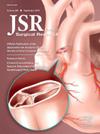Unveiling the Silent Threat: Disparities in Adrenal Incidentaloma Management
IF 1.7
3区 医学
Q2 SURGERY
引用次数: 0
Abstract
Introduction
Adrenal incidentalomas are increasingly detected, yet infrequently evaluated for hormonal excess. We investigated if patient neighborhood disadvantage is associated with the rate of workup of adrenal nodules.
Methods
We performed a retrospective analysis of chest and abdomen CT scans between January 1, 2021, and January 6, 2022, at a single tertiary care center in adults with an incidentally found adrenal mass. Chart review was conducted to categorize patients’ neighborhood disadvantage utilizing the Area Deprivation Index and evaluate for biochemical workup. Multivariate logistic regression was performed to determine factors associated with adrenal mass evaluation. A secondary chart review was conducted to ascertain reasons for incomplete adrenal nodule workup among disadvantaged patients.
Results
Among 245 included patients, most (71%) had no biochemical workup and only 11% received a guideline-concordant full evaluation. Patients living in disadvantaged neighborhoods were less likely to receive biochemical workup compared to patients in advantaged neighborhoods (odds ratio 0.51, 95% confidence interval 0.26-0.98). Additionally, scans ordered by primary care providers were associated with greater evaluation rates compared to emergency medicine providers (odds ratio 4.08, confidence interval 1.69-9.81). We identified three issues potentially contributing to low workup rates: radiologists recommended no further workup, primary care providers did not order additional tests, and patients were lost to follow-up.
Conclusions
The rate of guideline-based biochemical workup of adrenal incidentalomas was low at 11%, and over 70% had no evaluation at all. Patients from disadvantaged neighborhoods were significantly less likely to receive workup, as were patients seen through the emergency department.
揭示无声的威胁:肾上腺偶发瘤管理的差异
肾上腺偶发瘤越来越多地被发现,但很少被评估为激素过量。我们调查了患者的社区劣势是否与肾上腺结节的检查率有关。方法回顾性分析了2021年1月1日至2022年1月6日在一家三级医疗中心偶然发现肾上腺肿块的成人胸部和腹部CT扫描。利用区域剥夺指数(Area Deprivation Index)对患者的邻里劣势进行分类,并对生化检查进行评价。采用多变量logistic回归来确定与肾上腺肿块评估相关的因素。我们进行了二次图表回顾,以确定弱势患者肾上腺结节检查不完全的原因。结果在245例纳入的患者中,大多数(71%)没有进行生化检查,只有11%的患者接受了符合指南的全面评估。生活在弱势社区的患者接受生化检查的可能性低于生活在优势社区的患者(优势比0.51,95%可信区间0.26-0.98)。此外,与急诊医疗提供者相比,初级保健提供者订购的扫描与更高的评估率相关(优势比4.08,置信区间1.69-9.81)。我们确定了三个可能导致低检查率的问题:放射科医生不建议进一步检查,初级保健提供者没有要求额外的检查,患者没有随访。结论肾上腺偶发瘤的指南生化检查率较低,仅为11%,超过70%的肾上腺偶发瘤没有任何评估。来自弱势社区的患者接受检查的可能性明显较低,通过急诊科就诊的患者也是如此。
本文章由计算机程序翻译,如有差异,请以英文原文为准。
求助全文
约1分钟内获得全文
求助全文
来源期刊
CiteScore
3.90
自引率
4.50%
发文量
627
审稿时长
138 days
期刊介绍:
The Journal of Surgical Research: Clinical and Laboratory Investigation publishes original articles concerned with clinical and laboratory investigations relevant to surgical practice and teaching. The journal emphasizes reports of clinical investigations or fundamental research bearing directly on surgical management that will be of general interest to a broad range of surgeons and surgical researchers. The articles presented need not have been the products of surgeons or of surgical laboratories.
The Journal of Surgical Research also features review articles and special articles relating to educational, research, or social issues of interest to the academic surgical community.

 求助内容:
求助内容: 应助结果提醒方式:
应助结果提醒方式:


